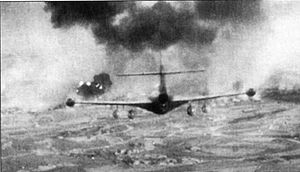1963 Argentine Navy Revolt
| 1963 Argentine Navy revolt | |||||||||
|---|---|---|---|---|---|---|---|---|---|
 A naval F9F Panther attacks the army’s 8th armored regiment |
|||||||||
|
|||||||||
| Government-Insurgents | |||||||||
|
|
|
||||||||
| Commanders and leaders | |||||||||
|
|
|
||||||||
| Military support | |||||||||
| Most of the Argentine Armed Forces | Part of the Argentine Armed Forces | ||||||||
| Casualties and losses | |||||||||
| 19 dead 22 wounded Several vehicles destroyed |
At least 5 dead 24 aircraft destroyed (mostly on the ground) |
||||||||
| Unknown overall casualties | |||||||||
The 1963 Argentine Navy revolt was a failed coup attempted by elements of the Argentine military that lasted from 21 September 1962 to 5 April 1963. The revolt was attempted by military officers that wanted the government to take a hardline stance against the political participation of Peronist politicians, the culmination of the conflict between Azules and Colorados. The revolt failed to gain much support in the Army and Air Force, and these two branches suppressed the uprising after some fighting that left 24 dead in both sides. The Argentine elections of 1963 proceeded as planned in July and the Navy saw a reduction of its influence.
In 1955, the once popular government of Juan Peron was overthrown in a military coup known as the Revolución Libertadora. The subsequent military-backed government banned the participation of Peronist politicians. However, divisions grew within the military between the so-called Azules (Blues), who favored allowing a limited degree of participation by Peronist candidates so as to preserve a veneer of legality, and the Colorados (Reds), who took a hardline stance against them and other left-wing groups and were in favor of a complete military take over.
In 1962, President Arturo Frondizi was forced to step down as a result of Peronist electoral victories in local elections, and was replaced by José María Guido who reinstituted the ban on openly Peronist candidates. However, the Azules faction, led by Army General Juan Carlos Onganía, agreed to hold presidential elections in 1963 that permitted former-Peronist candidates.
An attempted coup by the Colorados in 21 September 1962 was suppressed following an aerial bombardment in San Antonio de Padua, and many participating officers were forced to retire or demoted. Sporadic clashes were extended for the next six months.
Early in 1963, high-ranking officers from all three branches of Argentina's military agreed to attempt a coup to prevent the election from occurring that July, including Isaac Rojas (a former Vice President), General Benjamin Menendez, General Federico Montero, and Admiral Arturo Rial, Admiral Carlos Sanchez Sanudo, and Air Force Commodore Osvaldo Lentino. This conspiracy committed on March 24, 1963, to attempt a coup, and outlined in a 16-page 'Doctrina de Gobierno' (doctrine of government), their plan for the governance of Argentina, whose terms included the institution of liberal economic policies, bureaucratic decentralization, anti-communism, and the suppression of labor unions and university students. The conspirators agreed to launch the coup on 2 April and went about recruiting officers to their cause.
...
Wikipedia
